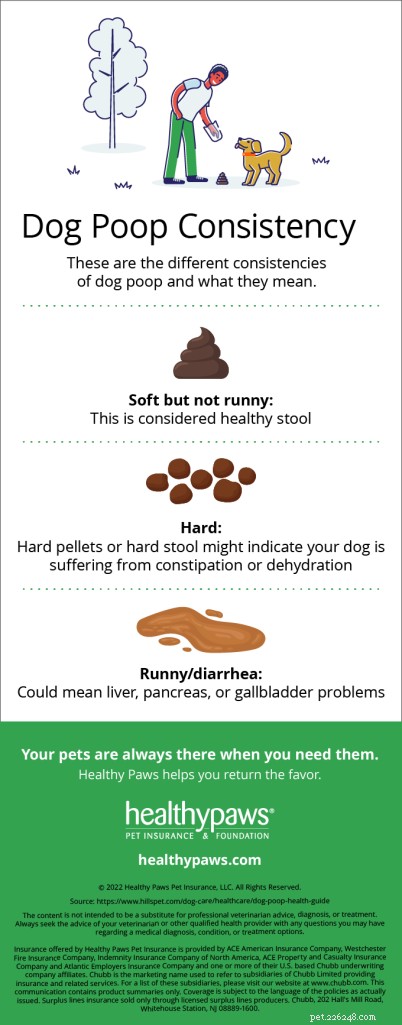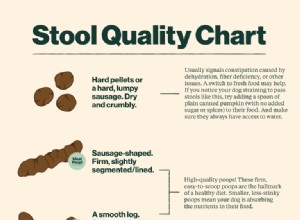獣医師 JoAnna Pendergrass によるレビュー、2022 年 6 月 29 日
あなたの人生に犬がいるなら、あなたは「うんちが起こる」ことをよく知っています。片付けなければならない臭いだけでなく、犬のうんちは健康の優れた尺度であるため、子犬のうんちが正しくない場合は注意する必要があります。
犬の糞に関しては、4 つの点に注意する必要があります。それらはすべて「C」で始まります:色、内容、一貫性、およびコーティングです。
犬が 1 日に「ナンバー 2」になる回数は、いくつかの要因によって異なります。食物とおやつの摂取量、ホルモン、運動量、新陳代謝、ストレスはすべて、排便頻度に影響を与える可能性があります。
成犬は少なくとも 1 日に 1 回排便する必要があります。多くの人は 1 日に 2 ~ 3 回通いますが、これはまだ正常と考えられています。子犬はより多くのうんちをします – 1 日に最大 5 回、またはそれ以上。
If your dog is not pooping at least once a day, they are constipated or have a blockage, and it warrants a vet visit. If your dog is pooping more than three times a day, it’s not necessarily a problem if the poop appears healthy. It’s more important to notice the quality of the poop than the quantity.
In general, expect your pooch to poop 8-12 hours after digesting their last meal. For many dogs, that works out to be mornings and evenings. However, every dog poops a little differently. Whatever time of day they regularly go is what’s normal for them.
Many dogs have bowel movements during a walk or romp because exercise makes food move faster through the large intestine.
Like humans, your dog may occasionally have to go at random or unexpected times. This may be stress-related or come down to how much food they consumed at their last meal, or if they ate foods that are not part of their regular diet.
The size and volume of your dog’s poop will depend on their size and weight and how much food they are consuming.
For most medium-sized dogs (20-60 lbs.), their poop will consist of two to three sections, totaling a few inches long. The number, diameter, and length of your dog’s normal feces will correspond to the size of the distal or descending colon, which matches the dog’s size.
What does ‘healthy’ poop look like?
Healthy dog poop should be somewhat firm in consistency, like play-dough. Ideally, it should look like a compact and soft log that will break into smaller pieces.
The poop should be chocolate brown, although the shade can vary from light to dark brown, depending on what kind of dog food your pup is eating. Poop should not contain blood, white spots (which indicate a parasite or worms), or other debris such as fur.
Finally, healthy excrement does not have any coating on it.
Not surprisingly, it should smell stinky like any feces but not be overpowering. The smell is going to depend on your dog’s diet. If you notice your pet’s poop smell changes suddenly, watch your dog for any other changes, such as reduced appetite or lethargy, and check with your vet if you are concerned.

Any color besides shades of brown can indicate a health issue, and you should discuss it with your veterinarian.
Sometimes, blood in your dog’s stool is nothing to be worried about, and it’s the result of a simple problem that will get better on its own in a day or two. For example, if your dog got into a red food, such as watermelon, the stool may appear bloody when it’s just the result of the red food.
If you only notice this happen once—and if the amount of blood present in the stool isn’t substantial—you can probably wait to see if it gets better. However, if it doesn’t go away, there may be a much more severe underlying problem to be addressed, said Vijay Nair, a veterinarian with Veterinary Emergency Group.
Sometimes dogs consume plastic or other items with sharp edges, which can cause cuts to the dog’s anus or colon. It may resolve itself in a day or so.
Bright red blood on the exterior of the stool may indicate hemorrhoids or other irritation near the outside of the anus.
Anal sacs are located on either side of the anus and contain anal glands. These glands squeeze out a stinky liquid that helps dogs poop more easily. When anal glands become impacted or infected, for reasons such as food allergies or a dietary fiber insufficiency, pooping becomes more difficult, causing a small amount of bright red blood in your dog’s poop. Besides blood in the stool, your dog may have trouble pooping, scoot his rear along the floor, or lick the anal area. Contact your veterinarian if your dog has anal sac issues.
If your dog’s stool is bright red and watery, it could indicate a serious condition. Bright red, bloody diarrhea is a symptom of several common illnesses, some of which are fatal, so your dog needs to be seen by a vet right away.
For puppies, even a small amount of red in their stool could indicate parvovirus, which can be fatal and should be treated immediately.
Black or tarry stool means the blood has come from somewhere further up in the digestive tract, usually near the stomach. This is often a sign of a much more severe problem and should trigger a vet visit immediately.
Dogs may develop black stool if they have tumors in their digestive system. Don’t panic, as it’s only one possibility, but it should be checked out.
Dogs that have ingested a toxic substance may have black blood in their stool. If you think there’s a chance your dog got into something toxic, take them to the vet immediately.
Dogs with severe kidney failure may have black blood in their stool and many other symptoms that will make them appear extremely sick. Dogs usually have an underlying condition that causes kidney failure.
Dogs can have black stool from pancreatitis or inflammatory bowel disease. Both these conditions are treatable, and you can manage them throughout your dog’s life with dietary changes and veterinarian-prescribed medications.
Black or bloody stool is one symptom of a stomach ulcer. Causes of stomach ulcers in dogs include Addison’s disease, liver disease, eating something toxic, medications, and a high-fat diet.

Healthy stool is soft but not runny. Ideally, it will be log-shaped. Waste that is either too hard or too runny can indicate a health problem.
Be sure to contact your veterinarian if your puppy or dog has blood in their stool or if it’s any color besides brown. Also, get help if your furry friend suffers diarrhea beyond 24-48 hours or has not had a bowel movement within 48-72 hours.
コンテンツは、専門の獣医師のアドバイス、診断、または治療に代わるものではありません。医学的診断、状態、または治療オプションに関して疑問がある場合は、常に獣医師または他の有資格の医療提供者のアドバイスを求めてください。

犬の健康に関しては、うんちに証拠がある場合があります。ほとんどの犬の飼い主は、一貫性の突然の変化(下痢の発作など)に精通していますが、うんちが突然異常な色に変わったり、サイズや形が変化したりした場合はどうでしょうか? まず、何が「正常」であるかを理解するのに役立ちます。原則として、犬の便がしっかりしていて、丸太の形をしていて、すくいやすく、チョコレートブラウンの色である場合、これらはすべて良い兆候であり、健康な消化管を示しています。ただし、「正常」は犬によって少し異なる場合があります。そのため、獣医師は、犬の飼い主が子犬の典型的なトイレの習慣と出力に注意を払い、何かが間違っている可能性がある

それは犬と一緒に暮らすことの最もかわいい部分ではありませんが、毎日うんちに対処することはあなたの子犬の健康についての情報を発見する良い機会です。ほとんどの犬の飼い主は、一貫性の突然の変化(下痢の発作など)に精通していますが、うんちが突然異常な色に変わったり、サイズや形が変化したりした場合はどうでしょうか? 何が「正常」であるかを理解するのに役立ちます。原則として、犬の便がしっかりしていて、丸太の形をしていて、すくいやすく、チョコレートブラウンの色である場合、これらはすべて良い兆候であり、健康な消化管を示しています。これらの「高品質のうんち」は、新鮮な食事の特徴の1つです。 犬の糞の解読につ